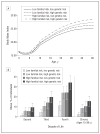Polygenic risk, rapid childhood growth, and the development of obesity: evidence from a 4-decade longitudinal study
- PMID: 22665028
- PMCID: PMC3534740
- DOI: 10.1001/archpediatrics.2012.131
Polygenic risk, rapid childhood growth, and the development of obesity: evidence from a 4-decade longitudinal study
Abstract
Objective: To test how genomic loci identified in genome-wide association studies influence the development of obesity.
Design: A 38-year prospective longitudinal study of a representative birth cohort.
Setting: The Dunedin Multidisciplinary Health and Development Study, Dunedin, New Zealand.
Participants: One thousand thirty-seven male and female study members.
Main exposures: We assessed genetic risk with a multilocus genetic risk score. The genetic risk score was composed of single-nucleotide polymorphisms identified in genome-wide association studies of obesity-related phenotypes. We assessed family history from parent body mass index data collected when study members were 11 years of age.
Main outcome measures: Body mass index growth curves, developmental phenotypes of obesity, and adult obesity outcomes were defined from anthropometric assessments at birth and at 12 subsequent in-person interviews through 38 years of age.
Results: Individuals with higher genetic risk scores were more likely to be chronically obese in adulthood. Genetic risk first manifested as rapid growth during early childhood. Genetic risk was unrelated to birth weight. After birth, children at higher genetic risk gained weight more rapidly and reached adiposity rebound earlier and at a higher body mass index. In turn, these developmental phenotypes predicted adult obesity, mediating about half the genetic effect on adult obesity risk. Genetic associations with growth and obesity risk were independent of family history, indicating that the genetic risk score could provide novel information to clinicians.
Conclusions: Genetic variation linked with obesity risk operates, in part, through accelerating growth in the early childhood years after birth. Etiological research and prevention strategies should target early childhood to address the obesity epidemic.
Figures




Comment in
-
Translating developmental genetic findings into obesity-related clinical practice: are we there yet?Arch Pediatr Adolesc Med. 2012 Jun 1;166(6):576-7. doi: 10.1001/archpediatrics.2012.704. Arch Pediatr Adolesc Med. 2012. PMID: 22665034 No abstract available.
-
Genetic risk in childhood obesity: implications for clinical practice.JAMA Pediatr. 2013 Feb;167(2):196-7. doi: 10.1001/2013.jamapediatrics.252. JAMA Pediatr. 2013. PMID: 23381454 No abstract available.
-
Genetic risk in childhood obesity: implications for clinical practice--reply.JAMA Pediatr. 2013 Feb;167(2):197-8. doi: 10.1001/2013.jamapediatrics.255. JAMA Pediatr. 2013. PMID: 23381455 No abstract available.
References
-
- McCarthy MI. Genomics, type 2 diabetes, and obesity. N Engl J Med. 2010;363(24):2339–2350. - PubMed
-
- Oken E, Gillman MW. Fetal origins of obesity. Obes Res. 2003;11(4):496–506. - PubMed
-
- Frongillo EA, Lampl M. Early identification of children at risk of developing obesity. Arch Pediatr Adolesc Med. 2011;165(11):1043–1044. - PubMed

